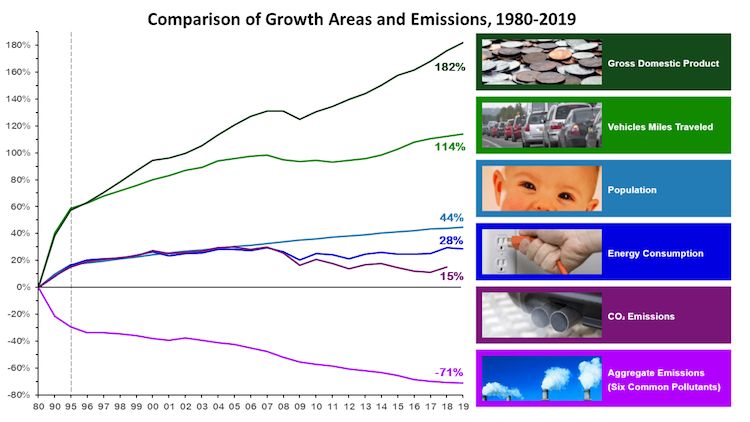Emission Modeling and Inventory Basic

This figure, created by the United States Environmental Protection Agency (EPA) for their Air Quality National Summary, shows a comparison of growth areas and emissions between the years 1980 - 2019.
Reading Guide
The US EPA "AP-42: Compilation of Air Emission Factors" is one of the most complete and useful references to calculate emission data for a large set of activities and scenarios. It contains emissions factors and process information for more than 200 air pollution source categories, including:
- External Combustion Sources
- Solid Waste Disposal
- Stationary Internal Combustion Sources
- Evaporation Loss Sources
- Petroleum Industry
- Organic Chemical Process Industry
- Liquid Storage Tanks
- Inorganic Chemical Industry
- Food and Agricultural Industries
- Wood Products Industry
- Mineral Products Industry
- Metallurgical Industry
- Miscellaneous Sources
- Greenhouse Gas Biogenic Sources
- Ordnance Detonation
Additional information on Air Emissions can be found on the EPA's pages for:
- Air Emissions Factors and Quantification
- Basic Information of Air Emissions Factors and Quantification
Emission Estimation Software include:
- TANKS - TANKS estimates volatile organic compound (VOC) and hazardous air pollutant (HAP) emissions from fixed- and floating-roof storage tanks
- SPECIATE - SPECIATE is the EPA's repository of organic gas and particulate matter (PM) speciation profiles of air pollution sources
- LandGEM - The Landfill Gas Emissions Model (LandGEM) is an automated estimation tool with a Microsoft Excel interface that can be used to estimate emissions rates for total landfill gas, methane, carbon dioxide, nonmethane organic compounds, and individual air pollutants from municipal solid waste landfills. It is available from the EPA's Clean Air Technology Center.
- WATER9 - WATER9, a wastewater treatment model, consists of analytical expressions for estimating air emissions of individual waste constituents in wastewater collection, storage, treatment, and disposal facilities; a database listing many of the organic compounds; and procedures for obtaining reports of constituent fates, including air emissions and treatment effectiveness
In Europe, the EMEP/EEA air pollutant emission inventory guidebook (formerly called the EMEP CORINAIR emission inventory guidebook) provides guidance on estimating emissions from both anthropogenic and natural emission sources.
Guide prepared by P. Zannetti (12/2020). For corrections or expansions please contact us.